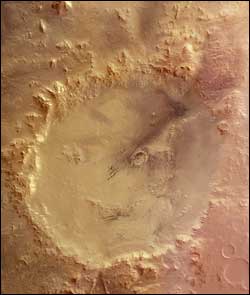’Happy face’ crater on Mars

Crater Galle, the ’happy face’ on Mars
These images, taken by the High Resolution Stereo Camera (HRSC) on board ESA’s Mars Express spacecraft, show the Galle Crater, an impact crater located on the eastern rim of the Argyre Planitia impact basin on Mars.
The HRSC obtained these images during orbits 445, 2383, 2438, 2460 and 2493 with a ground resolution ranging between 10-20 metres per pixel, depending on location within the image strip.
The images show Crater Galle lying to the east of the Argyre Planitia impact basin and south west of the Wirtz and Helmholtz craters, at 51° South and 329° East.
The images of the 230 km diameter impact crater are mosaics created from five individual HRSC nadir and colour strips, each tens of kilometres wide.
A large stack of layered sediments forms an outcrop in the southern part of the crater. Several parallel gullies, possible evidence for liquid water on the Martian surface, originate at the inner crater walls of the southern rim.
Crater Galle, named after the German astronomer J.G. Galle (1812-1910), is informally known as the ’happy face’ crater.
The ’face’ was first pointed out in images taken during NASA’s Viking Orbiter 1 mission.
Its interior shows a surface which is shaped by ’aeolian’ (wind-caused) activity as seen in numerous dunes and dark dust devil tracks which removed the bright dusty surface coating.
The colour scenes, false-colour and near true-colour, have been derived from three HRSC colour and nadir channels gathered during five overlapping orbits. The perspective views have been calculated from a mosaic of digital terrain models derived from the stereo channels.
The black-and-white high-resolution image mosaic was derived from the nadir channel which provides the highest detail of all channels. The resolution has been decreased for use on the Internet, to around 50 m per pixel.
Media Contact
More Information:
http://www.esa.int/SPECIALS/Mars_Express/SEMMTFNFGLE_0.htmlAll latest news from the category: Physics and Astronomy
This area deals with the fundamental laws and building blocks of nature and how they interact, the properties and the behavior of matter, and research into space and time and their structures.
innovations-report provides in-depth reports and articles on subjects such as astrophysics, laser technologies, nuclear, quantum, particle and solid-state physics, nanotechnologies, planetary research and findings (Mars, Venus) and developments related to the Hubble Telescope.
Newest articles

First-of-its-kind study uses remote sensing to monitor plastic debris in rivers and lakes
Remote sensing creates a cost-effective solution to monitoring plastic pollution. A first-of-its-kind study from researchers at the University of Minnesota Twin Cities shows how remote sensing can help monitor and…

Laser-based artificial neuron mimics nerve cell functions at lightning speed
With a processing speed a billion times faster than nature, chip-based laser neuron could help advance AI tasks such as pattern recognition and sequence prediction. Researchers have developed a laser-based…

Optimising the processing of plastic waste
Just one look in the yellow bin reveals a colourful jumble of different types of plastic. However, the purer and more uniform plastic waste is, the easier it is to…


